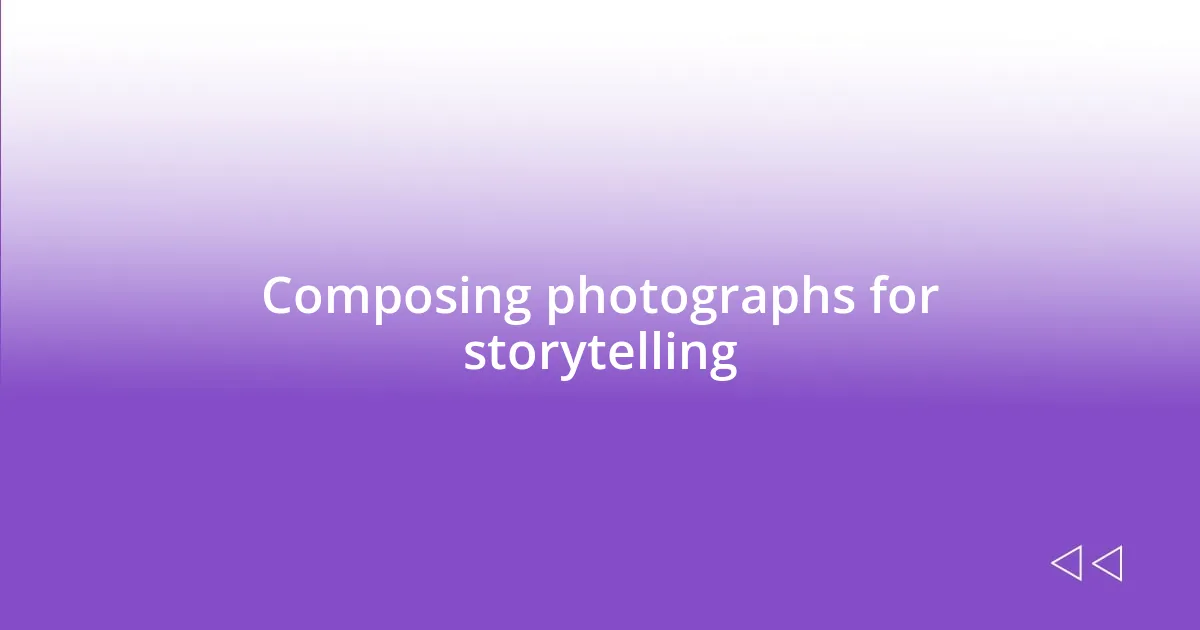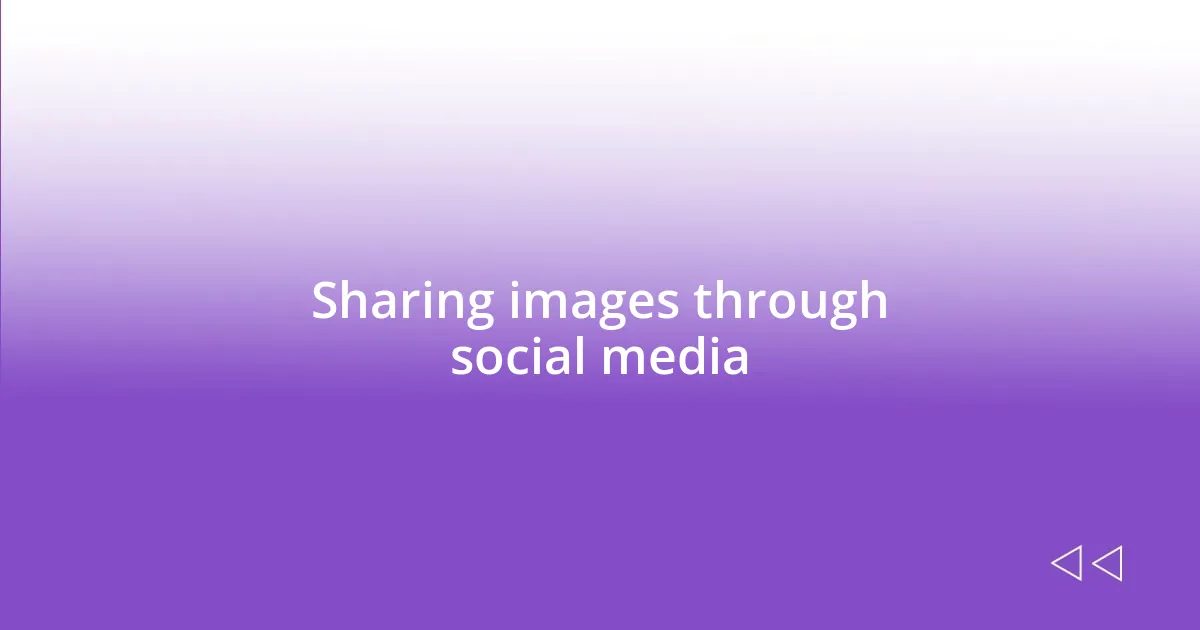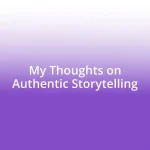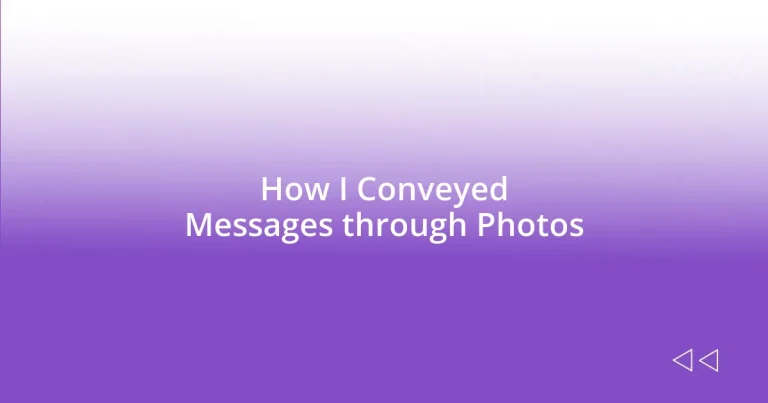Key takeaways:
- Photography captures and conveys emotions that words often cannot, serving as a powerful tool for storytelling and social change.
- Selecting authentic and emotionally resonant subjects enhances the storytelling aspect of photography, prioritizing genuine moments over staged shots.
- Lighting plays a crucial role in evoking emotions and transforming the mood of an image, highlighting the importance of experimenting with various lighting techniques.
- Sharing images on social media creates a unique dialogue between the photographer and the audience, where visuals and narratives can spark connection and conversation.

Understanding the impact of photography
Photography has an incredible ability to capture and convey emotions that words often fail to express. I remember standing at a wedding, watching the couple’s first dance through the lens of my camera. As I clicked the shutter, I felt the joy and love radiating from them; that single image carried a thousand unspoken words.
Every photo tells a story, right? Think back to a time when an image moved you. Perhaps it was a breathtaking landscape or a candid moment of laughter. Those visuals can evoke nostalgia or spark a sense of adventure. In my experience, the right photograph can transport a viewer to a different time or place, making them feel the intensity of the moment captured.
I’ve found that photography can also serve as a powerful tool for social change. When I volunteered at a local shelter, I documented the lives of the people there. Each photograph highlighted their resilience and struggles, creating a dialogue that could lead to understanding and compassion from those who viewed it. This transformative potential is one of the many reasons I believe in the impact of photography—it can inspire action and evoke empathy in ways that statistics alone cannot.

Selecting the right subject matter
Selecting the right subject matter is essential in photography; it shapes how your message is received. I recall a community event where I chose to focus on the faces of volunteers rather than the staged activities. Capturing their genuine smiles and moments of interaction told a richer story than any posed shot ever could. This experience reinforced for me the importance of prioritizing authenticity over perfection in my subject matter.
When considering your subject, think about the emotions you wish to convey. For instance, during a nature walk, I once captured a lone tree standing tall against a stormy sky. That image resonated deeply with viewers, eliciting feelings of strength in adversity. The contrast of the tree’s resilience against the chaotic backdrop sparked conversations about perseverance. It was a simple moment that communicated profound messages.
I’ve learned to explore unconventional subjects too; they often yield surprising insights. Last summer, I photographed the bustling streets of my city at night. Instead of focusing solely on landmarks, I captured everyday life—street vendors, late-night laughter, the expressive faces of people responding to their surroundings. These candid moments painted a more truthful picture of urban life and connected with viewers on a level that skyline photos often miss.
| Key Considerations | Example |
|---|---|
| Authenticity | Focus on genuine emotions, like capturing volunteers’ interactions at an event. |
| Emotional Resonance | Choose subjects that evoke feelings, like a lone tree in a storm suggesting resilience. |
| Unconventional Choices | Explore everyday life for deeper connections, like candid city street scenes rather than just landmarks. |

Composing photographs for storytelling
Composing photographs for storytelling involves a blend of thoughtful composition and emotional intent. I recall a moment while photographing a child blowing dandelion seeds. The lighting was soft, casting a warm glow around the child’s face. That simple action—the carefree joy of blowing away seeds—became a story of innocence and whimsy. I learned that a well-composed frame, with attention to background and interaction, can elevate a fleeting moment into a lasting narrative.
Here are some strategies I’ve found effective in composing photographs for storytelling:
-
Framing the Subject: Use natural frames, like doorways or branches, to draw attention to your subject. I once framed a couple’s embrace with tree branches that created a heart shape around them, enhancing the emotion of the moment.
-
Leading Lines: Utilize roads or pathways to guide the viewer’s eye into the image. This technique helped convey a sense of journey in my image of a person walking down a desolate road, suggesting both solitude and exploration.
-
Layering Elements: Incorporate different layers in your composition to add depth. In a crowded market scene, I highlighted a vendor in the foreground while capturing bustling customers in the background, telling a more immersive story of everyday life.
-
Capturing Movement: Freeze or blur motion to convey action and energy. I remember photographing a local dance performance; I intentionally blurred the dancers’ movements to capture the rhythm and excitement of the moment, making viewers feel the pulse of the event.
In my experience, effective photography is more than just capturing an image; it’s about creating a conversation between the viewer and the story behind the shot.

Using lighting to enhance emotion
Lighting is more than just a technical aspect of photography; it’s a powerful tool for evoking emotion. I remember a time when I experimented with backlighting during a sunset shoot. The way the sun filtered through the trees created a halo effect around my subject, which transformed a simple portrait into a scene brimming with warmth and nostalgia. It made me realize how light can shift a photo from flat to alive, instantly inviting viewers to feel something deeper.
Consider how different lighting can alter the mood of your images. During an early morning shoot, I played with soft, diffused light to capture the gentle awakening of a beach scene. The pastel hues of dawn created an ethereal quality that echoed serenity and peace. It’s incredible how much emotion can be conveyed just by changing the light source—don’t you think it’s worth taking the time to explore these nuances?
I often gravitate toward dramatic lighting to heighten tension in my work. In one instance, I captured a friend’s intense focus during a rehearsal under stark stage lights. The harsh shadows highlighted the determination etched on their face, instantly connecting viewers with the intensity of the moment. It reinforced my belief that lighting can serve as an emotional catalyst, compelling viewers to engage with the story in a more visceral way.

Sharing images through social media
Sharing images on social media has become a vibrant canvas where I express stories, emotions, and experiences. I remember posting a candid shot of my dog jumping into a puddle—an image that erupted with joy and laughter. The reaction was immediate; friends felt the splashes and the unfiltered happiness radiating from the frame. Isn’t it fascinating how a single photo can spark connection and conversation among people who’ve never met?
I’ve learned that the context in which an image is shared can completely shift its impact. For instance, I shared a photo of a sunset over a beach after a particularly tough day. I paired it with a reflective caption about finding peace in chaos. The responses flooded in, revealing how many had found solace in those same waves. It’s these moments that highlight the unique synergy social media provides—a platform where visuals and words collide to create meaning that resonates.
Each image I post feels like an invitation. Whether it’s a mesmerizing landscape or a simple cup of coffee, I’m inviting viewers to step into my world, to see through my eyes. There’s something magical about the way others interpret what I share. Sometimes they see joy, other times contemplation, and that’s where the beauty lies. It makes me wonder—what stories do your photos tell?

Engaging audience with visual narratives
Visually engaging an audience often hinges on crafting a narrative that resonates with them. I remember a time when I captured a series of city streets just before a thunderstorm. The dark clouds loomed overhead as pedestrians hurried along, each with their own story etched on their faces. By framing the shot to include both the stormy sky and the bustling crowd, I created a visual narrative that invited viewers to imagine their own tales amidst the chaos. Can you feel the tension and excitement in that moment?
Another experience that sticks with me is when I documented a local festival through a collection of images. I focused on the expressions of joy from children as they enjoyed their cotton candy. With each shot, I aimed to convey a sense of celebration and togetherness, immersing the viewers in the atmosphere of merriment. It’s amazing how genuine smiles can transform a photograph into a memory, drawing people into the experience—don’t you think emotions like joy transcend the barriers of language and culture?
When telling visual stories, I often use compositional techniques to create layers of meaning. In one project, I juxtaposed images of abandoned buildings with vibrant street art that breathed life into the desolation. This contrast sparked conversations about resilience and transformation, encouraging viewers to look beyond the surface. By engaging the audience in this way, I found that my photos became more than just static images; they evolved into a dialogue between the subject, the viewer, and the story waiting to be uncovered. Isn’t that what we strive for as storytellers?














